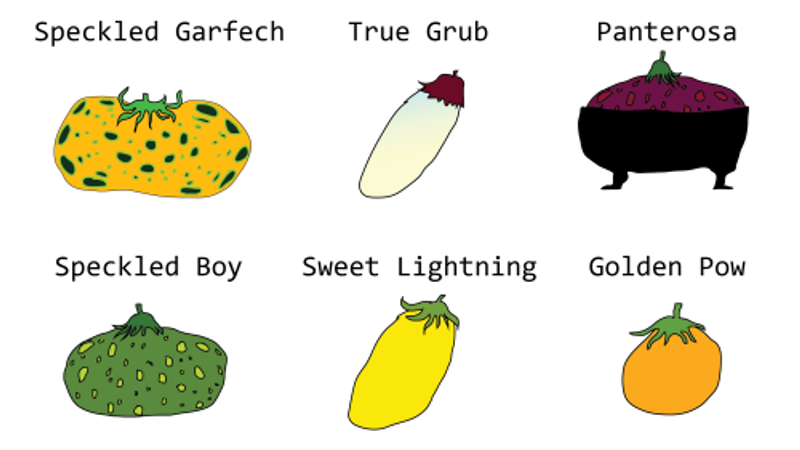Neural networks are a core area of the artificial intelligence field. They can be trained on abstract data sets and be put to all manner of useful duties, like driving cars while ignoring road hazards or identifying cats in images. Recently, a biologist approached AI researcher [Janelle Shane] with a problem – could she help him name some tomatoes?
It’s a problem with a simple cause – like most people, [Darren] enjoys experimenting with tomato genetics, and thus requires a steady supply of names to designate the various varities produced in this work. It can be taxing on the feeble human brain, so a silicon-based solution is ideal.
[Janelle] decided to use the char-rnn library built by [Andrej Karpathy] to do the heavy lifting. After training it on a list of over 11,000 existing tomato varieties, the neural network was then asked to strike out on its own.
The results are truly fantastic – whether you’re partial to a Speckled Garfech or you prefer the smooth flavor of the Golden Pow, there’s a tomato to suit your tastes. When the network was retrained with additional content in the form of names of metal bands, the results get even better – it’s only a matter of time before Angels of Saucing reach a supermarket shelf near you.
On the surface, it’s a fun project with whimsical output, but fundamentally it highlights how much can be accomplished these days by standing on the shoulders of giants, so to speak. Now, if you need some assistance growing your tomatoes, the machines can help there, too.
















Jannelle Shane has also done other neural network systems that didn’t go so well. http://aiweirdness.com/post/160776374467/new-paint-colors-invented-by-neural-network
The results, though disappointing, were also quite hilarious.
“smol pineapple”
(for those that remember listening to him…)
I can just imagine John Peel on his late-night radio show announcing “next up Angels of Saucing with Devil Potato Large Death…” (as some thrash metal starts fading in)
…although I notice that the “death metal” band names appears to be a running theme through a few of Jannelle’s AI experiments (I particularly like the juxtaposition of the metal band names with crochet patterns, in particular “Socks of Death”).
But she has at least done direct version: http://aiweirdness.com/post/160407271482/metal-band-names-invented-by-neural-network
Ah John Peel. How I miss thee.
needs more kvlt.
Do US based laws recognize computer based copyright creation? Recently a court ruled that a primate was not the copyright owner of a photo they took of themselves. Not exactly the same issue here as this is more of a practical naming process more subject to trademark than copyright and I suppose a person could use an AI tool to generate and then just register a resulting trademark but curious with respect to how this impacts US based copyright law when AI technology starts writing or creating actual content. In many ways, it is already starting to do so.
These would be considered trademarks rather than copyright. Trademarks trolling is much harder than patent trolling – you’re free to stock up on patents and bury them to keep it off the market (well, for 17 years… then you find your patented process has become public domain) if you’re so inclined, but a trademark requires either actual use or “bona fide intent to use the mark in commerce”. I’m not a lawyer, but I suspect anyone sitting on a stack of never-used trademarks is going to be laughed out of court if they tried to sue over them.
I tried to clarify that this usage is more trademark. For a single word that is seeking to protect a single product category, this seems fairly clear. But what happens when the AI writes an entire novel or song? That’s no longer a single word trademark issue is what I am getting at.
I’m not a copyright lawyer (or any lawyer), but I do understand copyright law slightly better than average, and I’ve followed NaNoGenMo for a few years. My opinion is that the AI system, as a computer program, is a copyrightable work by its creator, and the output (novel, drawing, song, etc.) is arguably a derivative work of the AI system, but either way is probably legally a copyrightable work by whoever told the AI system to create it (i.e. pressed the “generate” button). (I guess there may also be a human creative input in that the human may decide to keep the output or discard it and generate a new one.)
IIRC, if you press the shutter button on a camera, the resulting photo is your work (because copyright is automatic upon creation of the copyrightable work), even if someone else arranged the scene and aimed the camera. (They could, I guess, claim those things to be creative works, and your photo to therefore be a derivative work of those, but the photo would still be your work, just encumbered.)
This also gets interesting when things like this are developed: https://hackaday.io/project/47538-prosthetic-photographer
Speckled Garfech, you can get treatment for that now.
I really wasn’t expecting to see this pop up here.
They now want to pause AI
…. It is now a threat